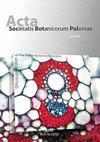细胞器基因组的纳米孔测序揭示了简单菌体和叶苔的异质性
IF 0.8
4区 生物学
Q3 PLANT SCIENCES
引用次数: 0
摘要
膜结合细胞器,如线粒体和叶绿体,在植物细胞的进化中起着至关重要的作用。在这项研究中,我们利用纳米孔测序技术研究了肝草(一组无维管植物)中异质性和基因组变异的存在。我们选取了代表不同谱系的4种苔属植物:<i>Riccia fluitans</i> <i>Apopellia endiviiolia< <i>; angela pinguis</i>;通过纳米孔测序,我们对选定的苔类植物的细胞器基因组进行了测序、组装和注释。Riccia fluitans</i>;Apopellia endiviiolia<; <i>; anopellia pinguis<;和<i>Scapania波动<;与先前发表的基因组表现出高度的保守性,而波状Scapania波状Scapania波状Scapania的有丝分裂基因组</i>这是该物种的首次报道。对肝草细胞器基因组的分析揭示了保守的基因含量、结构和顺序。我们进一步研究了苔类的异质性。质体分析没有发现结构异质性,这在一些被子植物中观察到,但似乎仅限于种子植物。然而,在有丝分裂基因组中,我们发现了异质性的证据,包括<i>动脉瘤</i>、<i>Apopellia endiviifolia</i>和<i>山葵</i>。有丝分裂基因组的异质位点主要表现为取代、索引和短串联重复多态性。一些鉴定的替换类似于在肝植物中观察到的RNA编辑模式。本研究强调了纳米孔测序在研究肝植物细胞器基因组和检测异质性方面的应用。这些发现扩大了我们对非维管植物细胞器基因组变异的理解,并为肝植物有丝分裂基因组异质性的机制提供了见解。异质性的功能意义及其在苔类进化和适应中的意义有待进一步研究。本文章由计算机程序翻译,如有差异,请以英文原文为准。
Nanopore sequencing of organellar genomes revealed heteroplasmy in simple thalloid and leafy liverworts
Membrane-bound organelles, such as mitochondria and chloroplasts, have played a crucial role in the evolution of plant cells. In this study, we investigate the presence of heteroplasmy and genomic variation in liverworts, a group of non-vascular plants, using nanopore sequencing technology. We selected four liverwort species representing different lineages: Riccia fluitans, Apopellia endiviifolia, Aneura pinguis, and Scapania undulata. Through nanopore sequencing, we sequenced, assembled, and annotated the organellar genomes of selected liverwort species. The plastid genomes of Riccia fluitans, Apopellia endiviifolia, Aneura pinguis, and Scapania undulata exhibited high conservation with previously published genomes, while the mitogenome of Scapania undulata represents the first report for this species. The analysis of the liverwort organellar genomes revealed conserved gene content, structure, and order. We further investigated heteroplasmy within the liverwort species. The plastome analysis did not detect structural heteroplasmy, which is observed in some angiosperms but seems limited to seed plants. However, in the mitogenomes, we found evidence of heteroplasmy in Aneura pinguis, Apopellia endiviifolia, and Scapania undulata. The heteroplasmic sites in the mitogenomes were mainly represented by substitutions, indels, and short tandem repeat polymorphisms. Some of the identified substitutions resembled RNA editing patterns observed in liverworts. This study highlights the utility of nanopore sequencing for studying organellar genomes and detecting heteroplasmy in liverworts. The findings expand our understanding of organellar genomic variation in non-vascular plants and provide insights into the mechanisms underlying heteroplasmy in liverwort mitogenomes. Further research is needed to explore the functional significance of heteroplasmy and its implications for liverwort evolution and adaptation.
求助全文
通过发布文献求助,成功后即可免费获取论文全文。
去求助
来源期刊
CiteScore
2.00
自引率
10.00%
发文量
18
审稿时长
1 months
期刊介绍:
The journal has been published since 1923 and offers Open Access publication of original research papers, short communications, and reviews in all areas of plant science, including evolution, ecology, genetics, plant structure and development, physiology and biochemistry.

 求助内容:
求助内容: 应助结果提醒方式:
应助结果提醒方式:


